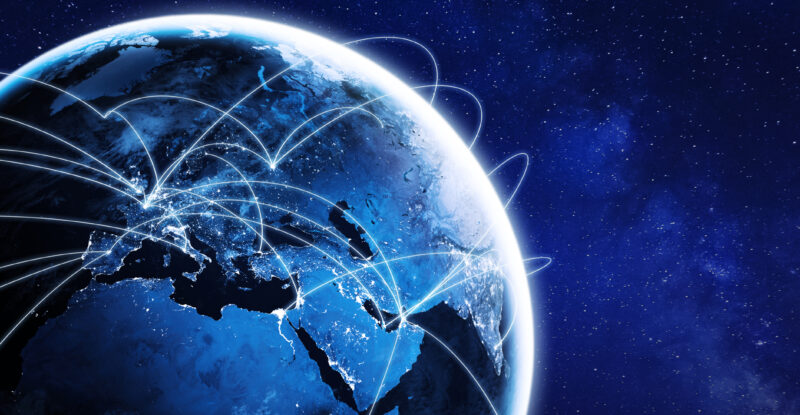A recent road trip through rural parts of New York, Connecticut and Maine proved instructive for this Verizon wireless customer: it reminded me that large swaths of the country still have limited, spotty or no cellular coverage in 2025, and candidly, it gave me a better appreciation for the value of direct-to-device (D2D) satellite communications for smart phones. Whilst traversing multiple dead zones over a ten-day period, I was comforted by the knowledge that my device could still make an emergency call, via satellite.
D2D is a very hot topic these days, and as many readers are aware, several big name satcom players are already actively involved, including but not limited to AST SpaceMobile, which has D2D arrangements in place with AT&T, Verizon and Vodafone; Globalstar, which already supports Apple’s proprietary Emergency SOS service on the iPhone 14 and later models; and Iridium Communications, which in May partnered with Syniverse, a leader in mobile interoperability, to support the rollout of its ‘Iridium NTN Direct’ service to mobile network operators (MNOs) worldwide.
Additionally, Lynk Global has formed a strategic partnership with SES to address the D2D segment; and SpaceX Starlink is in the midst of a public beta test of satellite-to-mobile connectivity with T-Mobile, following approval from the Federal Communications Commission. The T-Satellite-branded initiative is supported by hundreds of D2D-focused Starlink Low Earth Orbit (LEO) satellites, which act as cell towers in space; and it uses T-Mobile’s existing terrestrial spectrum, allowing standard LTE smart phones to connect.
Viasat also has designs on being a key player in D2D and is currently developing a D2D ecosystem of chipset manufacturers, MNOs, and OEMs. In April, the satellite operator and ISP demonstrated how its L-band geostationary satellites (acquired through its Inmarsat buy) and Skylo can provide narrowband tracking, monitoring and messaging capabilities to the automotive sector; and in May, it conducted a demonstration in Brazil of D2D service via L-band.
The Carlsbad, California-based company is also a founding member of a new satellite industry alliance called the Mobile Satellite Services Association (MSSA), a nonprofit that advocates for using existing mobile satellite service (MSS) spectrum to support D2D connectivity, as opposed to sharing terrestrial spectrum with MNOs. Its key initiatives include coordination of 3rd Generation Partnership Project (3GPP) standards, and other standards activities, as well as regulatory and space sustainability advocacy.
D2D and aviation
Runway Girl Network has been keeping half an eye on D2D advances in part because it will have some applications for casual flyers, not unlike how portable Iridium devices provide global voice, text messaging, SOS alerting and location tracking to general aviation pilots; and also because some of the same satellite networks serving cockpit communications and safety services over water today — namely the Iridium L-band LEO network and Viasat L-band GEO network — will facilitate D2D in other verticals through the adoption of 5G NTN (non-terrestrial network) standards, as defined by 3GPP.
We also continue to field questions from readers about whether business or commercial aviation stakeholders will find a way to support D2D services for smart phone-carrying passengers even though they typically don’t have direct line of sight to satellites on fast-moving jets.
Many challenges, including the high speed at which transport category aircraft fly and the inherent faraday cage limitations of their fuselages, as well as regulatory considerations — including around interference both with ground networks and onboard avionics — make D2D on commercial and business aircraft impractical. If additional hardware like an external antenna needs to be installed, it is reasoned, a dedicated onboard Wi-Fi network serving the whole cabin makes much more sense.
“I don’t see smartphones connecting well to satellites inside the metal tubes of airplanes — there will likely always be some kind of external antenna to create the best user experience to a satellite, whether it’s to Iridium or another satellite system,” Iridium CEO Matt Desch told RGN last year.
For its part, MSSA believes D2D services could have some benefits in aviation, including providing advanced new services. But new hardware would likely need to be adopted and meet the complexities and regulatory requirements of the air transport market, a MSSA representative noted via email.
We took the opportunity to get to know MSSA a little better. Launched in 2024, and boasting nearly two dozen members, the organization is seeking to advance global mobile connectivity for D2D and IoT services by utilizing L- and S-band spectrum which has already been allocated and licensed for MSS, and which is seen as being well-suited for integration into a broad range of mobile devices. “MSSA is looking at all ways to advance direct-to-device services to be the benefit of consumers,” the organization confides.
Please enjoy our Q&A with the association’s representative.
RGN: In recent months, in a bid to foster deeper integration between terrestrial and non-terrestrial networks, MSSA forged strategic collaborations with several other associations, including GSMA and the European Space Agency (ESA). Can you share some practical examples of how MSSA is collaborating with organizations such as GSMA and ESA on their shared goals?
Mobile Satellite Services Association: MSSA’s work with ESA and GSMA is focused on shared objectives and the creation of an ecosystem and environment that will allow the advancement of Direct-to-Device (D2D) services for the benefit of consumers. This open architecture, standards-based satellite network approach is focused on enabling seamless roaming among terrestrial and multiple cooperating satellite mobile networks, using existing and forthcoming standards and devices. ESA brings in European technology and support that can be achieved in a way that not only provides connectivity but also operate in compliance with sovereign telecom regulations.
The MSSA and GSMA collaboration is similarly aligned, with the aim of working and combining resources to advance the formation of the ecosystem where open, interoperable systems seamlessly connect terrestrial and non-terrestrial networks.
We also attended the 34th 5GAA F2F Meeting Week [the 5G Automotive Association meeting in Paris].
RGN: Have working groups been formed and if so, what is their remit (standards, best practices)?
Mobile Satellite Services Association: There are different working groups and committees within MSSA that are focused on advancing certain issues and priorities. For instance, there is a regulatory committee comprised of various members, and collectively they are responsible for submitting filings to regulatory bodies and other organizations around the world, including in the U.S., LATAM, Australia, Africa, and Europe. Governments are excited by the potential of D2D communications, but there remains a need for alignment on the regulatory frameworks needed to support this innovation while also protecting against issues like interference in cases where terrestrial spectrum is reused on satellites. MSSA working groups [are]: regulatory, technical, strategy, and marketing.
RGN: Are MSSA members quite active within the association?
Mobile Satellite Services Association: MSSA members are quite active and engaged on key issues affecting the advancement of integrated NTN services, supporting the use of open, interoperable standards and architectures, and the creation of a coordinated, cooperative ecosystem among all stakeholders. Of course, as with any association, there are going to be some members that are more active than others, but overall we’re really excited by the activity and engagement of members.
RGN: Is MSSA funding lobbying efforts on the Hill and elsewhere?
Mobile Satellite Services Association: MSSA engages in a number of different advocacy efforts. Examples of that work and related filings are available on the MSSA website.
RGN: What are the key benefits of using spectrum already allocated to MSS? And how is MSSA advocating for regulations to encourage this harmonization?
Mobile Satellite Services Association: MSSA members are aligned in supporting the use of MSS licensed spectrum. We believe this approach provides significant advantages, including enabling existing space networks to immediately offer Narrowband Internet of Things (NB-IoT) services; an existing global regulatory framework; no interference with terrestrial networks; and more spectrum to advance 5G New Radio (5G-NR) services. MSS spectrum also enables all MNOs to offer space/terrestrial integration in their entire service area without having to sacrifice terrestrial spectrum.
RGN: Is there a hope or expectation that Iridium, which operates a global L-band LEO network, will join MSSA? Is it necessary for MSSA to further its goals? (I note with interest that MSSA member Syniverse recently partnered with Iridium to bring D2D connectivity to MNOs).
Mobile Satellite Services Association: MSSA is open to having any additional members, including Iridium, that are aligned with the core aims and objectives of the Association. We have already formed a strong membership of 20+ organizations and are excited to continue momentum in building a unified voice that includes all ecosystem stakeholders and advancing open standards, interoperable architectures, and regulatory alignment for satellite-to-terrestrial mobile services.
Featured image credited to istock.com/NicoElNino












